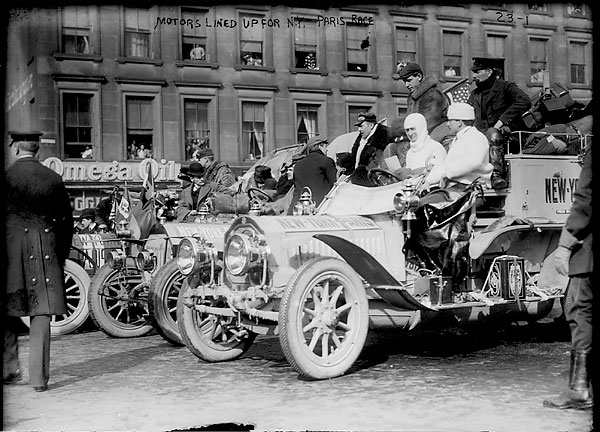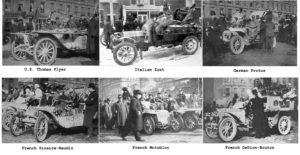
On February 12th 1908 the Great New York to Paris Automobile Race via San Francisco, Japan, Russia, and Berlin, left New York’s Time Square as 250,000 people watched. Cars participated from France, Italy, Germany, and the United States. Three days later the race passed through Syracuse and the cars faced a blizzard on the Camillus Hill west of the city, a place often used as a testing site for Franklin automobiles. The New York times centennial anniversary article mentions that the race “…was a historic undertaking; by 1908 only nine men had driven automobiles across the United States, none in winter. The fastest trip had taken 14 days.”
According to Bill Coffin for Canastota.com, “All three cars were reported to have used the towpath until ‘just before’ or ‘to’ Syracuse on Saturday, February 15. From the towpath there were two main routes to the Yates Hotel and Clinton Square in downtown Syracuse. The northern route into the city would have been the present Rt. 290 that ends with James Street. The southern route would have been East Genesee St. from Fayetteville.”
“Where did the drivers decide to leave the towpath to choose one of these routes? The clues point to Manlius Center. The first car to pass through there was the Thomas Flyer, and the clues to which way it went depend on knowing what the cars that followed did. Next was the DeDion, which became stuck in a mud hole on the towpath, which must have been just west of Manlius Center. Later, the Zust caught up, couldn’t get past the DeDion, and turned back to Manlius Center. Its driver later reported they passed the DeDion by way of a road.
“That road description fits Rt. 257 as it leaves Manlius Center to Fayetteville. The towpath can be seen from Rt. 257 for a half mile. Once in Fayetteville, the main road west becomes East Genesee St. in Syracuse. There is no clue yet that any race car arrived at downtown by way of James Street. A “pilot” car driven by H. R. Holmes was searching for and found the Flyer “east of Syracuse” to help guide it into the city. Holmes was a Syracuse Herald photographer. A second pilot car, driven by Richard E. Kolbe, was looking for and found the Zust. Only the DeDion is recorded to have arrived in Syracuse by East Genesee Street. It had no pilot car of its own. But the Zust was close behind the DeDion, even though the Zust left it in the mud back on the towpath. When the Kolbe pilot car was leading the Italian Zust, it must have been surprised to find the French DeDion ahead of it on East Genesee Street. It was reported in the Syracuse Herald that the Kolbe car surged ahead of the French car to “welcome” both cars into downtown. What looked like good international diplomacy on East Genesee St. was really a way out of an awkward situation. Otherwise, a French car, with a badly wobbling rear wheel, would beat both the Italians’ car and their pilot car before a huge crowd of people standing by the Yates Hotel.
“Still to be explained is how did the DeDion, stuck in the mud on the towpath, manage to beat the aggressively driven Zust to the Yates Hotel by seven minutes? This might also suggest which way the Thomas Flyer went.
“First Theory: The DeDion was quickly out of the mud hole and on its way after the Zust had left. The Zust crew said later it was not in serious trouble. The Flyer, a much lighter car, could have escaped the mud hole. The DeDion continued to follow the Flyer’s tire tracks west. This led to North Burdick St., the last good exit from the towpath before the city. A left turn to the south was only one mile west of Fayetteville and then a right turn on East Genesee Street. Meanwhile, the Zust had met its pilot car in Fayetteville and delayed enough to let the DeDion get ahead.
“Second Theory: The DeDion, after extricating itself from the mud hole, also turned back and followed the Zust on the road to Fayetteville. It looked like a better way than the miserable towpath after seeing the Zust speed away on the road up above. In Fayetteville, the Zust had just met its pilot car and was still talking when the DeDion suddenly zoomed past. Then a chase took place into Syracuse.
“It is probable that all three drivers had planned to use the same route into Syracuse, their objective that night of February 14. They had been driving close together because of difficult weather ever since the Hudson Valley, and they would be arriving in Syracuse after dark and again in bad weather. All three crews were together with the local automobile club advisors at lunch in Albany on the 13th and again at lunch in Utica on the 14th. Instead of reaching Syracuse, fog forced them to stop, and they stayed at the Weaver Hotel in Canastota. Icy cold rain turned the prior heavy snowfall into deep muddy slush. Road conditions were “awful,” and so were the choices. The icy cold rain continued on the 15th .
“After Montague Roberts drove the Flyer up to the Yates Hotel, he soon moved to the Western Union telegraph office to send his progress report to the race committee. Syracuse was an official checkpoint. T. W. Williams, a correspondent embedded on board the Flyer, wired his latest report to the New York Times. The car engineer, George Schuster, carefully looked over his machinery; that is, if he could see through the mud.
“West Genesee St. was the departure route from Syracuse toward Auburn for all the five race-surviving cars. A sixth had dropped out at Red Hook, NY, on the 13th. The DeDion didn’t stop in Syracuse, not even for a photo, and took its wobbly right rear wheel with it on to West Genesee Street. The Zust did stop, but not for long. Times correspondent, T. W. Williams, later wrote that usually the last car in to an official check point would not bother to register.”
The Buffalo, NY built Thomas Flyer, driven most of the race by mechanic and Buffalo native George Schuster, won in an elapsed time of 169 days, traveling 13,341 miles by land.
According to New York Heritage, “Legend has it that the Thomas Flyer entered the race at the insistence of President Theodore Roosevelt, who hated the prospect of European automobiles crossing the country unchallenged by Americans… The winning Thomas Flyer was restored to finish-line condition under supervision of George Schuster, who died in Springville in 1972 at age 99. It is on exhibit at the National Automobile Museum in Nevada.”


